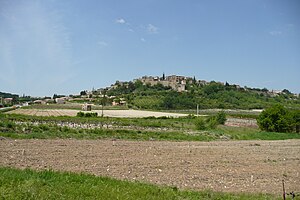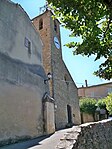Faucon
| Faucon | ||
|---|---|---|

|
|
|
| region | Provence-Alpes-Cote d'Azur | |
| Department | Vaucluse | |
| Arrondissement | Carpentras | |
| Canton | Vaison-la-Romaine | |
| Community association | Vaison Ventoux | |
| Coordinates | 44 ° 16 ' N , 5 ° 9' E | |
| height | 236-459 m | |
| surface | 8.65 km 2 | |
| Residents | 433 (January 1, 2017) | |
| Population density | 50 inhabitants / km 2 | |
| Post Code | 84110 | |
| INSEE code | 84045 | |

|
||
Faucon is a French municipality with 433 inhabitants (at January 1, 2017) in the department of Vaucluse in the region Provence-Alpes-Cote d'Azur . The municipality is assigned to the canton of Vaison-la-Romaine and the Arrondissement of Carpentras .
geography
The place is located at an altitude of 380 m near Mont Ventoux and is irrigated by the Ouvèze and its tributary Toulourenc . The climate is Mediterranean , but Faucon is exposed to the cold Mistral downwind, which blows at an average speed of 90 km / h for 120–160 days a year and lowers the statistical annual temperature. Without wind it can get very hot in summer; the local record was measured in August 2003 with 42.6 ° C. The main rainfall occurs in autumn and some rain can also be expected in spring; Winter and summer, on the other hand, are considered dry.
history
Faucon is a French common name for the raptor falcon . The place was also called Petit-Paris ('Little Paris') in the 19th century . The reason for this is unknown.
The area was already settled during the Neolithic Age. This is evidenced flints and finely crafted knife blades in the hamlet Beaupasset were found. In the Vallon de Gournier also were pottery unearthed from that period.
A parish dedicated to Saint-Pierre is first mentioned in 1120. In the 12th and 13th centuries the place belonged to the fiefdom of the Dukes of Poitiers and Toulouse until it passed into the possession of Pope Gregory X in 1274 . In 1565 the inhabitants bought their village back from the Holy See. Faucon has belonged to France since the formation of the Vaucluse department in 1793.
The first evidence of viticulture , which still plays an important role in the village today, dates from 1420.
Around the year 1800 the place had around 500 inhabitants. In the 19th century, in addition to wine, grain was also grown and fruit was grown in Faucon .
coat of arms
Description of the coat of arms : A golden hawk on an azure background posing on a golden masonry with three battlements; the whole inboard is surrounded by five golden besants ; three in the head and two on each flank; in the red head of the shield two crossed keys, one made of gold and the other made of silver.
Population development
| year | 1936 | 1946 | 1954 | 1962 | 1968 | 1975 | 1982 | 1990 | 1999 | 2008 |
|---|---|---|---|---|---|---|---|---|---|---|
| Residents | 231 | 206 | 201 | 233 | 243 | 263 | 287 | 346 | 380 | 411 |
economy
Viticulture
The vineyards of the place are in the wine-growing area of the southern Rhône valley . The classified wines may be marketed under the Denomination of Origin Puyméras AOC . In addition, the regionally widespread red wine Côtes du Rhône and the qualitatively more stringent Côtes du Rhône Villages are grown in Faucon .
tourism
In addition to wine lovers, the place also attracts hikers and cyclists. Faucon has numerous simple accommodation facilities.
Attractions
- Parish Church of Saint Germain
- Oratory Sainte-Colombe
- The ruins of a church, which was dedicated to Saint George , lie a little outside the village center. The bells were recovered during the demolition work and it is believed that one of them is built into the parish's bell tower.
- medieval arch
- Remains of a fortified castle
- Chapel of Notre-Dame des sept souleurs
- old bakery
- Saint-Germain Priory , Monument historique
Personalities
- Wim Duisenberg (* 1935), the first President of the European Central Bank , owned a villa in Faucon. He died there in 2005.
- The French novelist Violette Leduc (* 1907) bought a house in Faucon and renovated it. In 1972 she died there of breast cancer.
Individual evidence
- ↑ a b c Jules Courtet: Dictionnaire géographique, géologique, historique, archéologique et biographique du département du Vaucluse , p. 159f. Typographie de Bonnet fils, Avignon, 1857.
- ^ Des village Cassini
- ↑ Dominique de Labarre Raillicourt: Armorial du Comtat .





